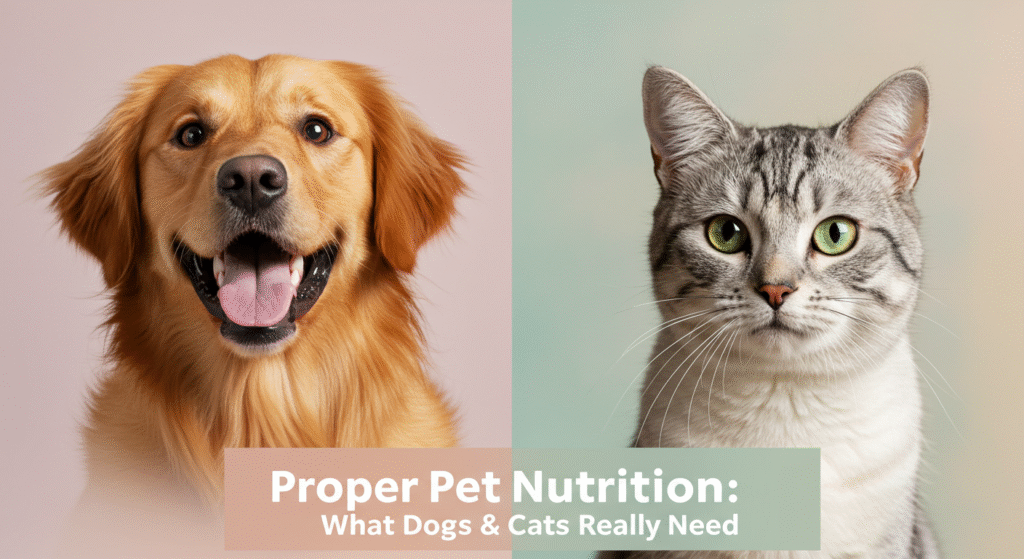Why Proper Nutrition Is the Real Secret to Happy, Healthy Pets
If you’ve ever stood in the pet food aisle staring at dozens of shiny bags labeled “grain-free,” “all-natural,” “raw,” “veterinarian approved,”—wondering which one is actually good for your fur baby—you’re not alone. Pet parents today have more food choices than ever. But here’s the catch: not all pet food is equal, and not all marketing is truthful.
The stakes are high, too. Nutrition isn’t just about filling your dog’s or cat’s belly—it’s about fueling their growth, energy, immunity, and long-term health. Poor nutrition can quietly contribute to obesity, diabetes, digestive struggles, and even shortened lifespans.
The good news? By learning the fundamentals of dog and cat nutrition, you can cut through the marketing noise and confidently choose diets that keep tails wagging and whiskers twitching.
In this guide, we’ll explore:
- What nutrients pets really need (and in what balance)
- The difference between dogs’ and cats’ dietary needs
- How to interpret pet food labels (without a chemistry degree)
- Common feeding mistakes pet owners make
- Actionable tips for portion control and mealtime success
- FAQs with quick, trustworthy answers
Let’s dig into the bowl (metaphorically, of course).
What Nutrients Do Dogs and Cats Actually Need to Stay Healthy?
When it comes to nutrition, pets—like humans—require six fundamental nutrient groups: protein, fats, carbohydrates, vitamins, minerals, and water. Let’s break these down.
Protein: The Building Block of Life
- Dogs: Dogs are omnivores. They thrive on animal protein but can also utilize some plant-based protein. Protein supports muscle development, repair, immune function, and energy.
- Cats: Cats are obligate carnivores—meaning they must obtain most of their protein from animal sources. Cats require more protein than dogs to maintain lean muscle and vital organ function.
Pro tip: For cats, look for taurine, an essential amino acid found only in animal tissue. Without enough taurine, cats can suffer from blindness and heart disease.
Fats: The Essential Energy Source
- Fats provide twice the energy of protein or carbs.
- They are vital for brain function, cell health, and the absorption of fat-soluble vitamins (A, D, E, K).
- They also give your pet that glossy coat and itch-free skin glowing with good health (the pet version of hair conditioner, you might say).
Sources: Fish oil, chicken fat, flaxseed oil (for dogs). Cats specifically need arachidonic acid, an essential fatty acid found only in animal fat.
Carbohydrates: Energy and Digestive Fiber
- Dogs can efficiently digest and benefit from complex carbs like brown rice, oats, sweet potatoes, and barley.
- Cats don’t biologically need carbs, but moderate amounts of digestible carbs (like rice) can provide energy.
- Fiber (from carbs such as pumpkin, oats, flax) supports healthy digestion.
Vitamins & Minerals: Micronutrients, Major Impact
- Essential vitamins: A, B complex, C (for dogs), D, E, and K.
- Key minerals: calcium, phosphorus, potassium, magnesium, iron, zinc.
- Cats must get Vitamin A and niacin from their diet (they can’t synthesize these like dogs).
Water: The Forgotten Hero
Water makes up 60–70% of an adult pet’s body weight. Dehydration can be deadly. Cats in particular are prone to low water intake, which increases urinary and kidney problems. Wet food + fresh water daily is often a winning combo.
How Are Dogs’ and Cats’ Nutritional Needs Different?
One of the biggest mistakes pet parents make is assuming dogs and cats can eat the same food. (Looking at you, folks who sneak Rover’s kibble to the cat when the dish is empty!)
Here’s the key distinction:
| Nutrient | Dogs | Cats |
|---|---|---|
| Protein Requirement | Moderate to high | Very high (must be animal-based) |
| Taurine | Can synthesize on their own | Must ingest from food (critical nutrient) |
| Carbohydrate Use | Can utilize for energy | Limited ability, not biologically required |
| Vitamin A & Niacin | Can synthesize from precursors | Must obtain from animal-sourced food |
| Fatty Acids | Can use plant & animal oils | Need certain animal-only fatty acids |
Bottom line: Cats are not small dogs. Their bodies run on different fuel. Feeding your cat dog food may seem harmless, but long-term it can cause serious nutrient deficiencies.
How to Read Pet Food Labels Without Going Cross-Eyed
Pet food labels can look like mini chemistry sets disguised as dinner menus. Marketers highlight “buzzwords” like grain-free or all-natural while hiding not-so-great ingredients further down the list.
Here’s how to decode them:
- Check the First 3 Ingredients
These make up most of the food. Ideally, the first ingredient should be a named animal protein (e.g., “chicken,” “salmon”), not vague “meat meal.” - Identify Protein Sources
Look for specific meat meals (chicken meal is better defined than just “meat meal”). Avoid ambiguous terms like “animal by-product meal.” - AAFCO Statement of Nutritional Adequacy
Look for a statement that says the food meets the standards of the Association of American Feed Control Officials (AAFCO). This means the formula is “complete and balanced” for your pet’s life stage. - Life Stage Matching
- Puppy/kitten food: Higher protein, energy density for growth.
- Adult maintenance: Balanced for healthy, grown pets.
- Senior: Adjusted calories and added nutrients for aging pets.
- Beware of Misleading Claims
- “Natural” doesn’t mean healthy.
- “Grain-free” isn’t automatically superior unless your pet has a true allergy.
What Are the Best Diet Options for Dogs and Cats?
Commercial Dry Kibble
Pros: Convenient, affordable, long shelf-life.
Cons: Less moisture (not ideal for cats prone to urinary issues).
Wet Canned Food
Pros: High moisture, flavorful, often higher protein.
Cons: More expensive, shorter shelf-life after opening.
Raw Diets (BARF – Biologically Appropriate Raw Food)
Pros: Mimics ancestral diet, high in protein.
Cons: Risk of bacterial contamination; requires careful handling and balancing.
Homemade Diets
Pros: Full ingredient control.
Cons: Easy to end up nutritionally unbalanced without veterinary guidance—supplementation is often needed.
How Much Should I Feed My Dog or Cat?
Overfeeding is one of the most common mistakes. Obesity significantly reduces lifespan and increases the risk of diabetes, arthritis, and heart disease.
Steps for Portion Control:
- Check Feeding Guidelines (on food packaging).
- Weigh, Don’t Guess: Use a kitchen scale or cup.
- Adjust to Activity Level:
- Active dogs = more calories.
- Indoor cats = fewer calories.
- Evaluate Body Condition Score (BCS):
- You should feel ribs without pressing hard.
- From above, a waistline should be visible.
- Regular Weigh-ins: Cats gain weight stealthily!
Common Pet Nutrition Mistakes Owners Make
- Feeding table scraps (especially onions, garlic, chocolate—all toxic).
- Misjudging portion size.
- Free feeding cats (promotes obesity).
- Listening to marketing over science.
- Ignoring regular vet nutrition checkups.
FAQs: Quick Answers for Busy Pet Parents
Q1: Can my dog eat cat food?
Occasionally, yes, but long-term no. Cat food is too high in protein and fat for dogs.
Q2: Can my cat eat dog food?
Dangerous long-term—cats can suffer taurine deficiency and organ damage.
Q3: Are grains bad for pets?
Not inherently. Most pets tolerate grains fine unless they have a genuine allergy (rare).
Q4: Is raw food safer than kibble?
It depends. Raw diets can be nutritious but pose contamination risks if mishandled.
Q5: How do I know my pet food is high-quality?
Look for meat as the first ingredient, no vague fillers, and an AAFCO nutritional adequacy statement.
Q6: Does my senior pet need a special diet?
Often yes—senior formulas support joint health and lower calorie needs. Always consult your vet.
Conclusion: Feeding Love in Every Bite
Proper nutrition isn’t just about scooping kibble from a bag—it’s about actively choosing diets that fuel your dog’s zoomies or keep your cat’s purring motor running strong for years to come. By understanding the essentials of protein, fats, vitamins, minerals, carbs, and water—and tailoring those needs to each species—you’re giving your pet the foundation for a longer, healthier life.
The best part? You don’t need to obsess or have a vet degree in your back pocket. With mindful label reading, portion control, and a few smart swaps, you’ll be the proud parent of a vibrant, thriving companion.
🐾 Now go check that food label—and give your fur friend an extra scratch behind the ears for being your loyal taste tester in life.

